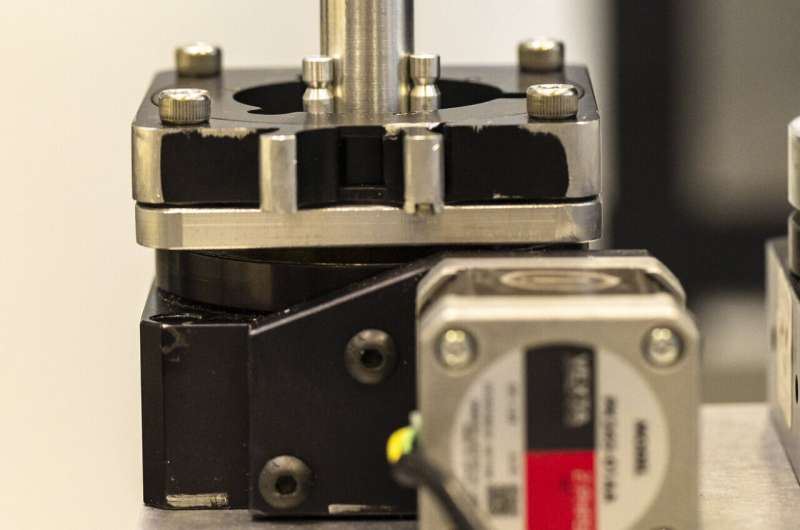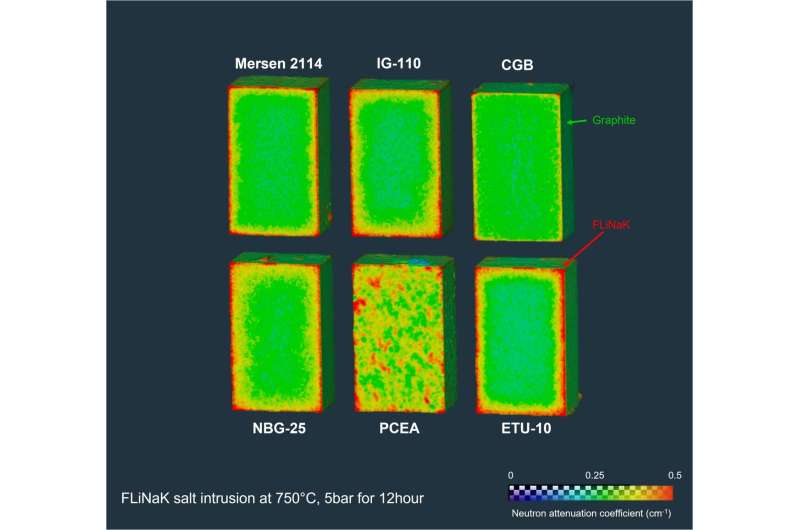This article has been reviewed according to Science X's editorial process and policies. Editors have highlighted the following attributes while ensuring the content's credibility:
fact-checked
peer-reviewed publication
trusted source
proofread
Researchers demonstrate novel technique to observe molten salt intrusion in nuclear-grade graphite

In response to a renewed international interest in molten salt reactors, researchers from the Department of Energy's Oak Ridge National Laboratory have developed a novel technique to visualize molten salt intrusion in graphite.
During ORNL's revolutionary Molten Salt Reactor Experiment, or MSRE, in the 1960s, scientists first demonstrated the feasibility of nuclear fission reactions with molten fluoride salt used both as a fuel carrier and as a coolant, substituting for the solid fuel and water used in traditional nuclear reactors. Molten salt reactor designs show great promise as a means of carbon-free power generation.
To slow down neutrons so they can easily promote nuclear fission, nuclear reactors use a material called a moderator. To moderate the MSRE, scientists used synthetic graphite, which is resistant to thermal shock and dimensionally stable because of its extensive pore system resulting from the manufacturing process.
MSRE graphite was custom-made and specially coated to decrease porosity and defend against detrimental effects that may occur when hydraulic and gas pressures cause molten salt to seep into graphite's pores. Moreover, preventing molten salt intrusion avoids additional issues with waste management during reactor decommissioning.
Following the conclusion of ORNL's experiment in 1969, the potential of molten salt reactors was largely unexplored until the 21st century, and low demand for the specialized graphite led to the material's discontinuation among domestic graphite manufacturers. With an uptick in molten salt reactor research but no MSRE graphite, today's scientists must identify an alternative graphite to successfully moderate nuclear reactions in molten salts.
However, ambiguity around the effects of molten salt intrusion poses a barrier to discovery. Scientists have a limited understanding of what microscopic features enable some graphite grades to withstand intrusion better than others and how salt intrusion affects graphite's other properties.
Hoping to resolve these uncertainties, a team of ORNL scientists led by Nidia Gallego and Jisue Moon studied molten salt intrusion across various graphite grades and have validated the first technique to visualize and monitor molten salt penetration depth and distribution in graphite's pores.
"It's critical for us as materials scientists to help test and develop techniques that we can use or have a better perspective on what we need to do to understand how the salt that goes into the pores may affect the mechanical or the thermal properties of the graphite," said Gallego, a distinguished R&D staff scientist in ORNL's Chemical Sciences Division.
Traditionally, scientists measure salt intrusion by weighing graphite before and after exposure to molten salt. ORNL researchers hoped to gain a more detailed understanding of intrusion by actually looking at what happens inside the graphite.
Gallego and Moon, an R&D associate scientist in the Radioisotope Science and Technology Division, first tried X-ray tomography to evaluate salt intrusion, but the time-consuming method required smaller sample sizes and could not provide enough contrast for a close look inside graphite's pores.
The team moved on to neutron imaging, which is suitable for large-volume sample sizes.

"Before we started using neutron imaging, we had to destroy the sample to visualize salt intrusion using microscopy techniques," Moon said. "However, with neutron imaging, we can do a three-dimensional computed tomography scan of the whole sample to visualize the salt distribution, and then we can perform additional analysis as needed."
Using the Multimodal Advanced Radiography Station instrument at the High Flux Isotope Reactor, or HFIR, a DOE Office of Science user facility at ORNL, the researchers achieved the first 3D, direct visualization of molten salt distribution in graphite pores, a novel accomplishment.
In neutron imaging, neutron attenuation coefficients, which describe how a neutron beam is reduced as it passes through a material, vary greatly between graphite and fluoride salt. This difference created a strong visual contrast between the materials that researchers observed when reconstructing sections of the graphite.
"Neutron imaging is perfect because it really allows us to visualize where the salt is going," Gallego said.
Using the 3D reconstructions, Gallego and Moon compared molten salt penetration in graphite's pores across grades of varying particle size. Under the specific pressure and temperature conditions used in the salt exposure experiments, researchers determined that in most superfine grain graphites, penetration was nonuniform, limited to the first few millimeters below the graphite's surface and localized around the perimeter of the sample cross section.
In medium-fine-grain graphite, which has larger pores than superfine graphite, the salt penetrated deeper into the material and fully covered the area of the sample cross section.
The team ultimately identified graphite microstructure, which describes the size and distribution of pores, as the most important factor in determining molten salt penetration and density distribution for a given temperature and pressure.
"Molten salt intrusion could significantly affect the operation of molten salt reactors," Moon said. "This research can help us see the impact of the salt in the graphite materials and thus can help us develop more standardized methods to design the proper graphite."
After publishing their findings in Carbon, Gallego and Moon are continuing research with HFIR scientists to improve neutron imaging resolution and observe molten salt intrusion with additional temperature, pressure and time variables.
"There's a lot from the technique perspective, a lot of improvements, developments that are possible and are of interest to the scientists that will also give us a lot of insight into the dynamics and the kinetics of the process," Gallego said.
Ultimately, the team hopes to develop predictive models to describe how different graphite grades respond to salt intrusion and refine molten salt reactor operating standards, which denote material and technical requirements for reactors but lack specification about preferred graphite grades.
"Understanding how the graphite interacts with the salt is critical," Gallego said.
More information: Jisue Moon et al, A neutron tomography study to visualize fluoride salt (FLiNaK) intrusion in nuclear-grade graphite, Carbon (2023). DOI: 10.1016/j.carbon.2023.118258















